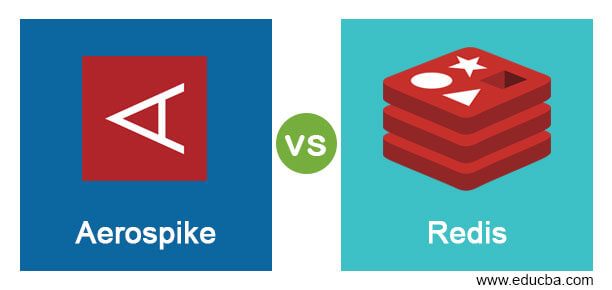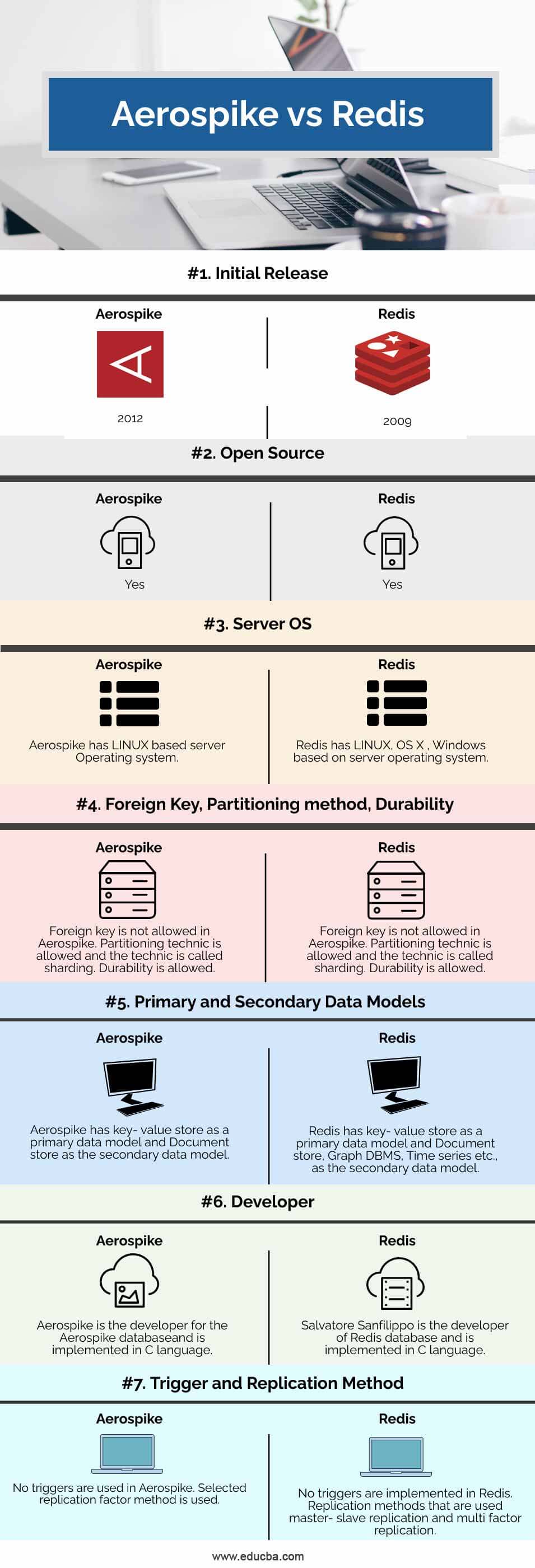Updated April 7, 2023

Difference Between Aerospike vs Redis
Aerospike is an in-memory NoSQL database. The initial release was done in 2012. It is open-source. It is not based on cloud-based. It was implemented in the C language. As the Aerospike is based on a NoSQL database the data scheme is schema-free. It allows Partitioning and allows Durability. Map or Reduce method is implemented in the Aerospike. Redis is an in-memory data structure store. The initial release was done in 2009. It is open-source. It is not based on cloud-based. The data scheme is schema-free. It allows Partitioning and allows Durability. The map or Reduce method is not implemented in the Redis.
Head to Head Comparison between Aerospike vs Redis (Infographics)
Below is the top 7 Comparison between Aerospike vs Redis:
Key Differences between Aerospike vs Redis
Let’s discuss the top comparison between Aerospike vs Redis:
Aerospike has a key-value store as a primary data model and a Document store as the secondary data model. Coming to the performance of Aerospike hundreds of operations per second will be done. Aerospike has its own hardware-specific drivers. Scalability in high in Aerospike. Aerospike is used for large datasets. It does automatic sharding. Aerospace has a better self-healer technic and allows the master-slave replication method. In which if one node fails the other node takes place of it and runs. The workload is distributed accordingly across the cluster. It is a Dynamic Data Rebalancer used for data migration and rebalancing. Indexing is purely in memory. Smart cluster management allows the features of Heartbeat synchronization, Clustering, and so on. It has cross data center replication which allows the features of the logger, shipper, node failure handler, and link failure handler. In Aerospike job scheduling and monitoring can be done.
Some of the commands used in Aerospike:
- Backup: asbackup
- Restore: asrestore
- Loader: asloader
- Validation: validation
- Latency: asloglatency
- Admin: asadms
For understanding the data structure model and storage model. Let us consider the basic retrieval operation that are done. Below are the retrieval operations that we use Aerospike let us have a look:
- To Retrieve user records we use the below command
- Get operation.
- To Retrieve tweets for a user we use the below command
- Batch read operation.
- Username with Equality filter on it.
- To Retrieve tweets for all users we use the below operation
- Scan All operations.
- To Retrieve users with count within a specified time period (Range)
- Secondary Index on count is used to retrieve.
- Count on the Query using Range filter can also be used.
- Retrieve Users with count within the specified time period (Range), and aggregate users by region
- Count on Secondary Index.
- Count on the Query using Range filter.
- Stream UDF aggregates by user region.
Redis has key-value store as a primary data model and a Document store, Graph DBMS, Time series etc., as the secondary data model. Redis supports its own hardware specific drivers but designed with RAM. It also allows automatic sharding with the help of Redis cluster. The Redis cluster allows upto 1000 nodes. If we are using a small database, then it would be perfect. The replication method is a selected factor because of which it is not that effective as Aerospike database. Multiple databases are possible based on the Redis enterprise cluster. Sharding is done for the performance behavior of Redis. Quota will be assigned for each database and it should not exceed the available quota. Durability is maintained in the Redis as a dual copy in a disk. Replication is also maintained in the Redis. Redis is a conflict-free replication database. Concurrent reads and writes can be handled smartly conflict-free replication database.
Some of the commands used in Redis:
Cluster: CLUSTER ADDSLOTS slot[slot],CLUSTER info, CLUSTER NODES, CLUSTER MEET ip port, CLUSTER MYID, CLUSTER REPLICATE etc.,
Hashes: HGET key field, HLEN key, etc.,
Keys: DEL, DUMP, EXISTS, MOVE, OBJECT, etc.,
Script: EVAL, EVALSHA, SCRIPT DEBUG, SCRIPT KILL, SCRIPT LOAD, SCRIPT FLUSH SCRIPT EXISTS
Comparison Table of Aerospike vs Redis
The table below summarizes the comparisons between Aerospike vs Redis:
| Feature | Aerospike | Redis |
| Initial Release | 2012 | 2009 |
| Open Source | Yes | Yes |
| Server OS | Aerospike has LINUX based server Operating system. | Redis has LINUX, OS X , Windows based on server operating system. |
| Foreign Key, Partitioning method, Durability | Foreign key is not allowed in Aerospike. Partitioning technic is allowed and the technic is called sharding. Durability is allowed. | Foreign key is not allowed in Aerospike. Partitioning technic is allowed and the technic is called sharding. Durability is allowed. |
| Primary and Secondary Data Models | Aerospike has key- value store as a primary data model and Document store as the secondary data model. | Redis has key-value store as a primary data model and Document store, Graph DBMS, Time series etc., as the secondary data model. |
| Developer | Aerospike is the developer for the Aerospike database and is implemented in C language.. | Salvatore Sanfilippo is the developer of the Redis database and is implemented in the C language. |
| Trigger and Replication Method | No triggers are used in Aerospike. A selected replication factor method is used. | No triggers are implemented in Redis. Replication methods that are used master-slave replication and multi-factor replication. |
Conclusion
- Aerospike is an in-memory NoSQL database. The initial release was done in 2012. It is open-source. It is not based on cloud-based. It was implemented in the C language. As the Aerospike is based on a NoSQL database the data scheme is schema-free. It allows Partitioning and allows Durability. Map/ Reduce method is implemented in the Aerospike.
- Important factors for Aerospike are: – Partitioning, Index Management, Replication method, Reliable, Scalable, Consistency, Concurrency, and Durability.
- Redis is an in-memory data structure store. The initial release was done in 2009. It is open-source. It is not based on cloud-based. The data scheme is schema-free. It allows Partitioning and allows Durability. Map/ Reduce method is not implemented in the Redis.
- Important factors for Redis: – Partitioning, Index Management, Replication method, Reliable, Scalable, Consistency, Concurrency, and Durability.
Recommended Articles
This is a guide to Aerospike vs Redis. Here we also discuss the Aerospike vs Redis key differences with infographics and comparison table. You may also have a look at the following articles to learn more –

